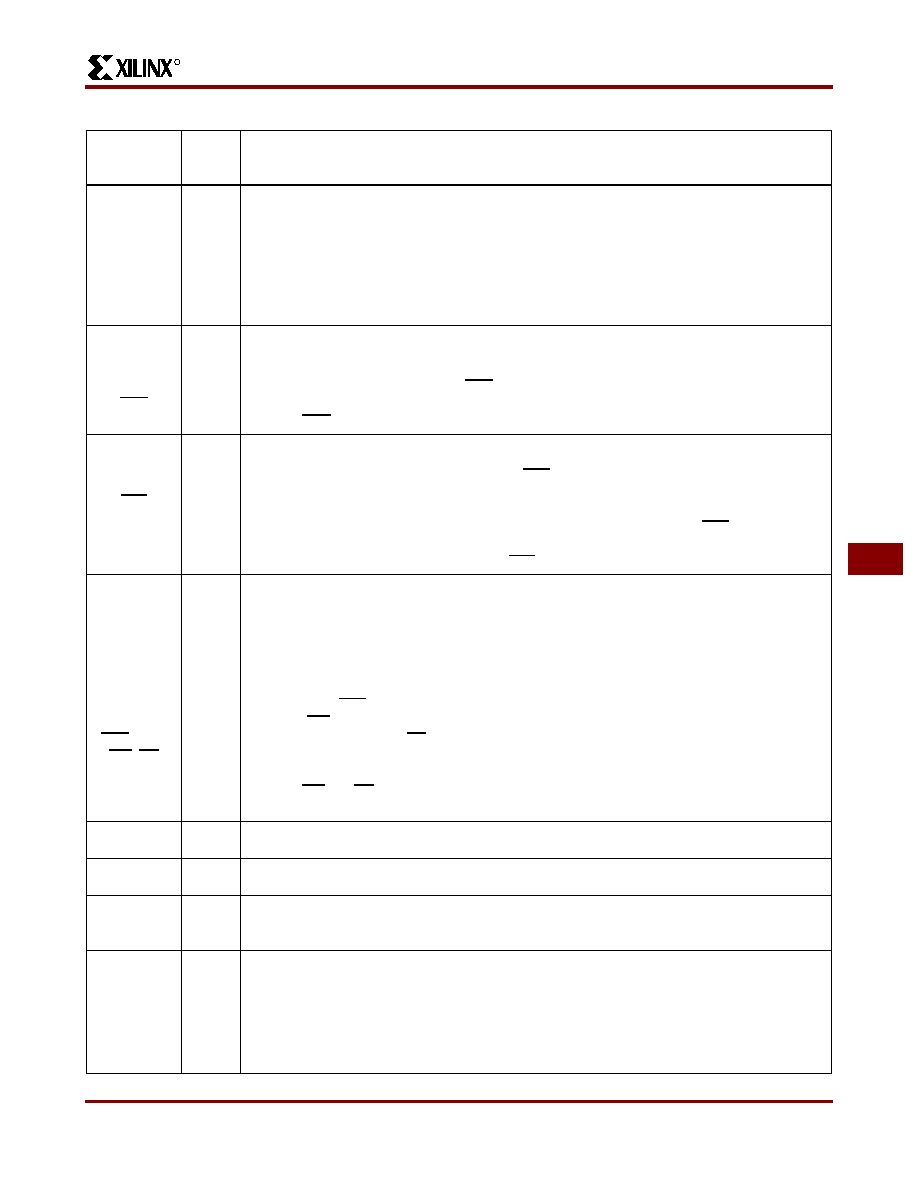- 您現(xiàn)在的位置:買賣IC網(wǎng) > PDF目錄4174 > XC5206-5PQ208C (Xilinx Inc)IC FPGA 196 CLB'S 208-PQFP PDF資料下載
參數(shù)資料
| 型號: | XC5206-5PQ208C |
| 廠商: | Xilinx Inc |
| 文件頁數(shù): | 14/73頁 |
| 文件大?。?/td> | 0K |
| 描述: | IC FPGA 196 CLB'S 208-PQFP |
| 產(chǎn)品變化通告: | XC1700 PROMs,XC5200,HQ,SCD Parts Discontinuation 19/Jul/2010 |
| 標準包裝: | 24 |
| 系列: | XC5200 |
| LAB/CLB數(shù): | 196 |
| 邏輯元件/單元數(shù): | 784 |
| 輸入/輸出數(shù): | 148 |
| 門數(shù): | 10000 |
| 電源電壓: | 4.75 V ~ 5.25 V |
| 安裝類型: | 表面貼裝 |
| 工作溫度: | 0°C ~ 85°C |
| 封裝/外殼: | 208-BFQFP |
| 供應(yīng)商設(shè)備封裝: | 208-PQFP(28x28) |
| 其它名稱: | 122-1142 |
第1頁第2頁第3頁第4頁第5頁第6頁第7頁第8頁第9頁第10頁第11頁第12頁第13頁當前第14頁第15頁第16頁第17頁第18頁第19頁第20頁第21頁第22頁第23頁第24頁第25頁第26頁第27頁第28頁第29頁第30頁第31頁第32頁第33頁第34頁第35頁第36頁第37頁第38頁第39頁第40頁第41頁第42頁第43頁第44頁第45頁第46頁第47頁第48頁第49頁第50頁第51頁第52頁第53頁第54頁第55頁第56頁第57頁第58頁第59頁第60頁第61頁第62頁第63頁第64頁第65頁第66頁第67頁第68頁第69頁第70頁第71頁第72頁第73頁

R
November 5, 1998 (Version 5.2)
7-103
XC5200 Series Field Programmable Gate Arrays
7
TDI, TCK,
TMS
I
I/O
or I
(JTAG)
If boundary scan is used, these pins are Test Data In, Test Clock, and Test Mode Select
inputs respectively. They come directly from the pads, bypassing the IOBs. These pins
can also be used as inputs to the CLB logic after configuration is completed.
If the BSCAN symbol is not placed in the design, all boundary scan functions are inhib-
ited once configuration is completed, and these pins become user-programmable I/O.
In this case, they must be called out by special schematic definitions. To use these pins,
place the library components TDI, TCK, and TMS instead of the usual pad symbols. In-
put or output buffers must still be used.
HDC
O
I/O
High During Configuration (HDC) is driven High until the I/O go active. It is available as
a control output indicating that configuration is not yet completed. After configuration,
HDC is a user-programmable I/O pin.
LDC
OI/O
Low During Configuration (LDC) is driven Low until the I/O go active. It is available as a
control output indicating that configuration is not yet completed. After configuration,
LDC is a user-programmable I/O pin.
INIT
I/O
Before and during configuration, INIT is a bidirectional signal. A 1 k
- 10 k external
pull-up resistor is recommended.
As an active-Low open-drain output, INIT is held Low during the power stabilization and
internal clearing of the configuration memory. As an active-Low input, it can be used
to hold the FPGA in the internal WAIT state before the start of configuration. Master
mode devices stay in a WAIT state an additional 50 to 250
s after INIT has gone High.
During configuration, a Low on this output indicates that a configuration data error has
occurred. After the I/O go active, INIT is a user-programmable I/O pin.
GCK1 -
GCK4
Weak
Pull-up
I or I/O
Four Global inputs each drive a dedicated internal global net with short delay and min-
imal skew. These internal global nets can also be driven from internal logic. If not used
to drive a global net, any of these pins is a user-programmable I/O pin.
The GCK1-GCK4 pins provide the shortest path to the four Global Buffers. Any input
pad symbol connected directly to the input of a BUFG symbol is automatically placed on
one of these pins.
CS0, CS1,
WS, RS
II/O
These four inputs are used in Asynchronous Peripheral mode. The chip is selected
when CS0 is Low and CS1 is High. While the chip is selected, a Low on Write Strobe
(WS) loads the data present on the D0 - D7 inputs into the internal data buffer. A Low
on Read Strobe (RS) changes D7 into a status output — High if Ready, Low if Busy —
and drives D0 - D6 High.
In Express mode, CS1 is used as a serial-enable signal for daisy-chaining.
WS and RS should be mutually exclusive, but if both are Low simultaneously, the Write
Strobe overrides. After configuration, these are user-programmable I/O pins.
A0 - A17
O
I/O
During Master Parallel configuration, these 18 output pins address the configuration
EPROM. After configuration, they are user-programmable I/O pins.
D0 - D7
I
I/O
During Master Parallel, Peripheral, and Express configuration, these eight input pins re-
ceive configuration data. After configuration, they are user-programmable I/O pins.
DIN
I
I/O
During Slave Serial or Master Serial configuration, DIN is the serial configuration data
input receiving data on the rising edge of CCLK. During Parallel configuration, DIN is
the D0 input. After configuration, DIN is a user-programmable I/O pin.
DOUT
O
I/O
During configuration in any mode but Express mode, DOUT is the serial configuration
data output that can drive the DIN of daisy-chained slave FPGAs. DOUT data changes
on the falling edge of CCLK.
In Express mode, DOUT is the status output that can drive the CS1 of daisy-chained
FPGAs, to enable and disable downstream devices.
After configuration, DOUT is a user-programmable I/O pin.
Table 9: Pin Descriptions (Continued)
Pin Name
I/O
During
Config.
I/O
After
Config.
Pin Description
Product Obsolete or Under Obsolescence
相關(guān)PDF資料 |
PDF描述 |
|---|---|
| ABB65DHAS | CONN EDGECARD 130PS R/A .050 SLD |
| XC5206-6PQ160C | IC FPGA 196 CLB'S 160-PQFP |
| GSC49DTEI | CONN EDGECARD 98POS .100 EYELET |
| XC5206-5PQ160C | IC FPGA 196 CLB'S 160-PQFP |
| ACB65DHAS | CONN EDGECARD 130PS R/A .050 DIP |
相關(guān)代理商/技術(shù)參數(shù) |
參數(shù)描述 |
|---|---|
| XC5206-5PQ208C0262 | 制造商:Xilinx 功能描述: |
| XC5206-5PQ208I | 制造商:未知廠家 制造商全稱:未知廠家 功能描述:Field Programmable Gate Array (FPGA) |
| XC5206-5PQ240C | 制造商:XILINX 制造商全稱:XILINX 功能描述:Field Programmable Gate Arrays |
| XC5206-5TQ144C | 功能描述:IC FPGA 196 CLB'S 144-TQFP RoHS:否 類別:集成電路 (IC) >> 嵌入式 - FPGA(現(xiàn)場可編程門陣列) 系列:XC5200 產(chǎn)品變化通告:XC4000(E,L) Discontinuation 01/April/2002 標準包裝:24 系列:XC4000E/X LAB/CLB數(shù):100 邏輯元件/單元數(shù):238 RAM 位總計:3200 輸入/輸出數(shù):80 門數(shù):3000 電源電壓:4.5 V ~ 5.5 V 安裝類型:表面貼裝 工作溫度:-40°C ~ 100°C 封裝/外殼:120-BCBGA 供應(yīng)商設(shè)備封裝:120-CPGA(34.55x34.55) |
| XC5206-5TQ144C0262 | 制造商:Xilinx 功能描述: |
發(fā)布緊急采購,3分鐘左右您將得到回復(fù)。